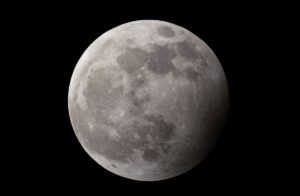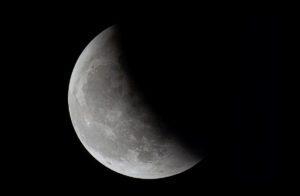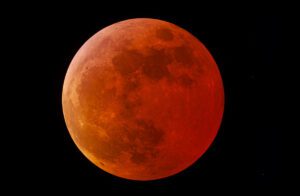Lunar eclipses
A lunar eclipse occurs when our satellite passes through the shadow cast by the Earth in space. Therefore, the Moon has to be in the full Moon phase.
The Earth casts a shadow with two differentiated zones: the shadow, an interior region where no ray of sunlight reaches directly, and the penumbra, a concentric zone that surrounds the shadow, which is partially illuminated by sunlight.
There are several types of lunar eclipses:
Penumbral eclipse
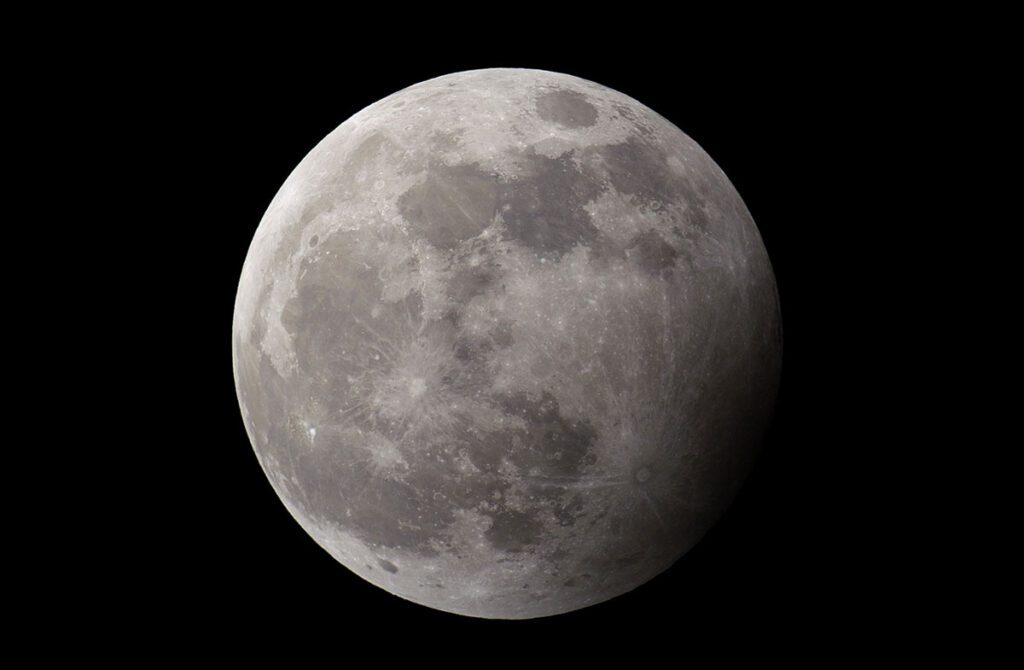
The Moon is only covered, in part or totally, by the terrestrial penumbra.
The darkening of the lunar disk is very mild and is only noticeable if there is a large percentage of occultation.
Upcoming penumbral lunar eclipses (2023-2028)
- 25 March 2024. The eclipse occurs in Spain at moonset.
- 20 February 2027. Eclipse visible from Spain.
- 18 July 2027. Invisible from Spain.
- 17 August 2027. The eclipse will be partial penumbral, very weak, only observable from the western part of the Iberian Peninsula and especially in the Canary Islands, just before moonset.
Partial eclipse
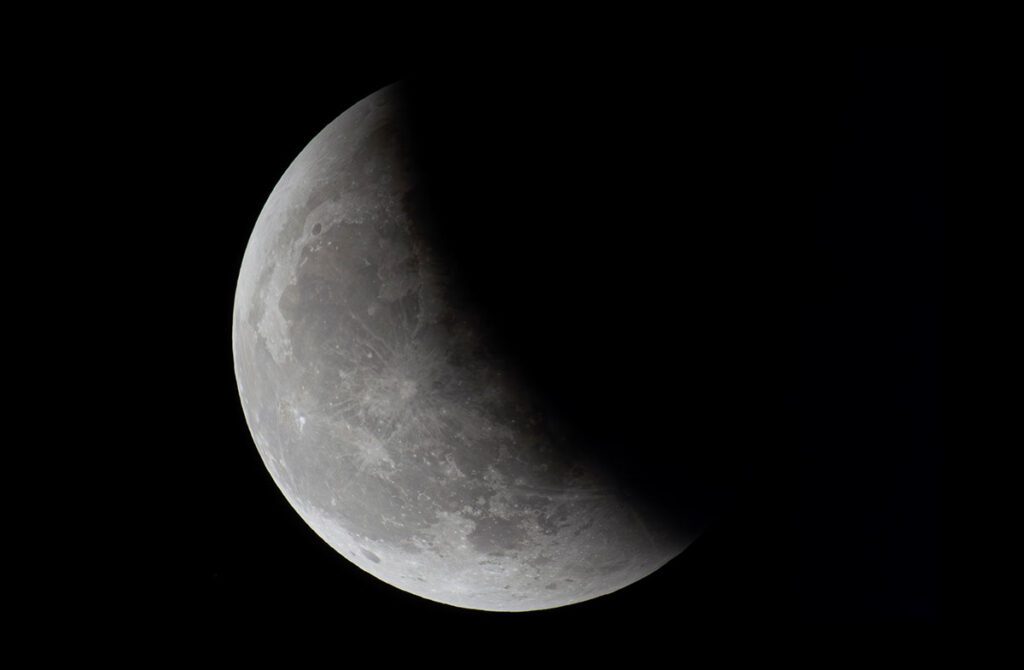
Our satellite is partly hidden by the Earth’s shadow.
The edge of the shadow is dark and perfectly visible, although it presents a translucency, since the Earth has an atmosphere that blurs the definition of the outline of its shadow.
Upcoming partial lunar eclipses (2023-2028)
- 28 October 2023. Eclipse of weak occultation (12%), visible at the beginning of the night in Spain.
- 18 September 2024. Eclipse of weak occultation (8%), visible at dawn in Spain.
- 28 August 2026. Deep, almost total eclipse (93%). The maximum phase will be visible in Spain just before sunset.
- 12 January 2028. Eclipse of very weak occultation (6%), visible in Spain.
- 6 July 2028. Eclipse of maximum occultation of 39%. From Spain it will only be visible as a penumbral eclipse at moonrise.
Total eclipse

The phenomenon begins as a penumbral eclipse and continues with an umbral eclipse phase. Once the shadow completely covers the disk of the Moon, it does not disappear, but rather takes on a reddish coloration, although the tones and brightness in this phase of totality vary from one eclipse to another.
This reddish illumination during totality is due to the Earth’s atmosphere, which acts as a lens, refracting the sun’s rays and diverting them towards the Moon.
The duration of the totality of a lunar eclipse can reach almost two hours.
Upcoming total lunar eclipses
(Total visibility zones are indicated).
- March 14, 2025. American continent (north and south), Europe and West Africa. From Spain, the Moon will be totally eclipsed.
- September 7, 2025. Asia, Australia, Europe and East Africa. From Spain the Moon will be totally eclipsed.
- March 3, 2026. East Asia and Australia, New Zealand, Western United States and Canada, Hawaiian Islands. It is not visible from Spain.
- December 31, 2028. Asia, Australia, Eastern Europe and Africa. From Spain the Moon will be totally eclipsed.
La Lluna només és tapada, en part o totalment, per la penombra terrestre.
L’enfosquiment del disc lunar és molt suau i només és perceptible si hi ha un gran percentatge d’ocultació.
Propers eclipsis penombrals de lluna (2023-2028)
- 25 març 2024. L’eclipsi es produeix a Espanya a la posta de Lluna.
- 20 febrer 2027. Eclipsi visible des d’Espanya.
- 18 juliol 2027. Invisible des d’Espanya.
- 17 agost 2027. L’eclipsi serà parcial penombral, molt feble, només observable des de la zona oest de la península ibèrica i sobre tot a Canàries, just abans de la posta de Lluna.
El nostre satèl·lit és en part ocultat per l’ombra terrestre.
La vora de l’ombra és fosca i perfectament visible, encara que presenta una translucidesa, ja que la Terra té una atmosfera que difumina la definició del contorn de la seva ombra.
Propers eclipsis parcials de lluna (2023-2028)
- 28 octubre 2023. Eclipsi de feble ocultació (12 %), visible al principi de la nit a Espanya.
- 18 setembre 2024. Eclipsi de feble ocultació (8 %), visible a la matinada a Espanya.
- 28 agost 2026. Eclipsi profund, gairebé total (93 %). La fase màxima serà visible a Espanya just abans de la posta de Lluna.
- 12 gener 2028. Eclipsi de molt feble ocultació (6%), visible a Espanya.
- 6 juliol 2028. Eclipsi d’ocultació màxima del 39%. Des d’Espanya només serà visible com eclipsi penombral a la sortida de la lluna.
El fenomen s’inicia com un eclipsi penumbral i continua amb una fase d’eclipsi llindar. Un cop l’ombra cobreix completament el disc de la Lluna, aquest no desapareix, sinó que pren una coloració vermellosa, encara que els tons i la brillantor en aquesta fase de totalitat varien d’un eclipsi a un altre.
Aquesta il·luminació vermellosa durant la totalitat és deguda a l’atmosfera terrestre, que actua com una lent refractant els raigs solars i desviant-los cap a la Lluna.
La durada de la totalitat d’un eclipsi de Lluna pot assolir gairebé dues hores.
Propers eclipsis totals de Lluna
(S’indiquen les zones de visibilitat total).
- 14 març 2025. Continent americà (nord i sud), Europa i Àfrica occidental. Des d’Espanya, la Lluna es pondrà totalment eclipsada.
- 7 setembre 2025. Àsia, Austràlia, Europa i Àfrica oriental. Des d’Espanya la Lluna sortirà totalment eclipsada.
- 3 març 2026. Est d’Àsia i Austràlia, Nova Zelanda, oest dels Estats Units i Canadà, illes Hawaii. No és visible des d’Espanya.
- 31 desembre 2028. Àsia, Austràlia, est d’Europa i Àfrica. Des d’Espanya la Lluna sortirà totalment eclipsada.

